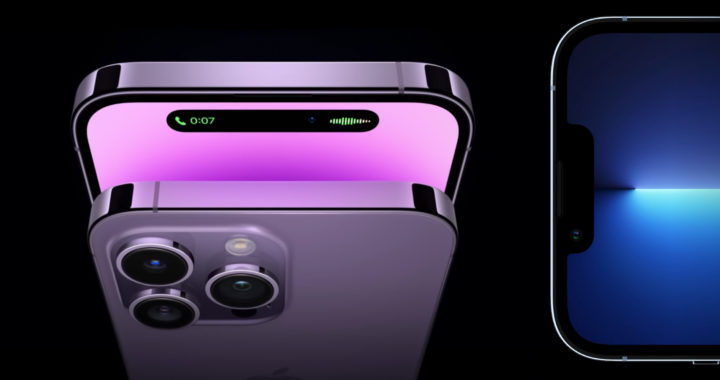Both the iPhone 14 Pro and iPhone 14 Pro Max are two of the four devices launched during the September 2002 Apple Event and for the entire iPhone 14 lineup. These two devices succeeded the iPhone 13 Pro and iPhone 13 Pro Max from last year. How exactly do these new models of iPhones differ or compare with the previous models?
The Difference Between iPhone 14 Pro/iPhone 14 Pro Max and iPhone 13 Pro/iPhone 13 Pro Max
An average individual can readily spot the key difference between the iPhone 14 Pro/iPhone 14 Pro Max and the iPhone 13 Pro/iPhone 13 Pro Max. However, beyond the surface, there are several new hardware features and specifications. Take note of the following:
A16 Bionic Chip vs A15 Bionic Chip
From under the hood, a key difference between the new iPhone 14 Pro and Pro Max models compared to the iPhone 13 Pro and Pro Max models is the newer A16 Bionic system-on-a-chip. Note that the previous generation uses the A15 Bionic chip.
The newer A16 chip is based on the N4 5nm process node while the older 15 chip is based on the standard 5nm process node. The newer one has 16 billion transistors compared to the 15 billion transistors of its processor, as well as an improved Neural Engine capable of 17 trillion operations per second or TOPS compared to the 15.8 TOPS of the previous Neural Engine, and an improved image signal processor.
Note that the difference might not be substantial, especially when referencing the differences between the A15 Bionic and the A14 Bionic. Still, the A16 Bionic makes the iPhone 14 Pro and iPhone 14 Pro Max faster and more capable than their predecessors.
It is also worth mentioning that the mid-range iPhone 14 models, the iPhone 14 and iPhone 14 Plus, sport the same A15 Bionic chip found on the flagship iPhone 13 models. Hence, they essentially and generally deliver the same processing capabilities and overall performance efficiencies as the iPhone 13 Pro and iPhone 13 Pro Max.
Better OLED Display Technology
Several similarities between the flagship iPhone 14 and iPhone 13 models. For starters, both have the ProMotion feature or adaptive refresh rate of between 0Hz to as high as 120Hz and the so-called Super Retina XDR for brighter screen output.
However, the iPhone 14 Pro and iPhone 14 Pro Max offer better OLED displays. Their screens have 1000 nits of brightness that peak to 1600 nits and further to about 2000 nits when used outdoors. Both screens also have the Always-On feature found on Samsung and other Android smartphones. The iPhone 13 Pro and 13 Pro Max have 1200 nits max brightness.
All iPhone models include the True Tone feature. Furthermore, the iPhone 14 Pro and iPhone 13 Pro have 6.1-inch screens with 460 ppi pixel density while the iPhone 14 Pro Max and iPhone 13 Pro Max have 6.7-inch screens with 458 ppi pixel density.
Dynamic Display Rear Camera Cutout
Apple finally geared away from the eyebrow notch for the iPhone 14 Pro and Pro Max and replaced it will at pill-shaped camera cutout for the rear camera module. Note that the mid-range iPhone 14 and 14 Plus still feature the same notch found on their predecessors.
However, the new cutout is not a mere simple cutout that houses the rear camera module and the face-recognition hardware for the Apple Face ID. Apple calls it the Dynamic Display. This new feature brings forth a novel way of interacting with the latest iPhone that is somewhat similar to the Touch Bar of the 13-inch MacBook Pro.
Dynamic Display provides additional and exclusive functionalities such as displaying interactive information, switching between apps, or accessing different functions or settings. The specific interface has a smooth animation that grows and shrinks accordingly.
Newer Camera Specs and Capabilities
The iPhone 13 Pro and iPhone 13 Pro Max have a 12-megapixel TrueDepth front-facing camera module. The iPhone 14 Pro and iPhone 14 Pro Max also have a 12-megapixel TrueDepth front-facing camera but with autofocus.
On the rear, the 14 Pro and 14 Pro Max have better camera specs. The 48-megapixel wide camera is the most obvious addition. There is also a newer 2x 12-megapixel telephoto camera, as well as dual-LED and dual-tone flash. The 12-megapixel ultrawide camera remains the same as the previous iPhone 13 Pro and 13 Pro Max ultrawide cameras.
The newer flagship iPhone models also support the Action Mode camera feature, as well as 3x better low-light photography on the ultrawide camera, 2x on the main camera sensor, and 2x on the telephoto due to the better sensors and improved image signal processor.
Other Key Similarities and Differences
Note that the iPhone 13 Pro and 13 Pro Max were introduced with the same price tags as the 14 Pro and 14 Pro Max. Apple ensured that its specific pricing strategy for the most latest generation of the iPhone remain similar or closer to the original prices of the preceding generation. The similar pricing is also indicative of fewer differences between generations.
Both generations of flagship-grade iPhone models also use stainless steel chassis. This material is sturdier than the aluminum chassis of mid-range iPhones such as the iPhone 13 and iPhone 13 Mini, as well as the iPhone 14 and Phone 14 Plus.
The glass on all models is a glass-ceramic material that Apple called Ceramic Shield. The company noted that this material can provide up to four times better drop resistance, clearer optical performance, and general resistance from scratch. Note that Corning, the manufacturer of Gorilla Glass, is also the manufacturer of Ceramic Shield.
The iPhone 13 Pro and iPhone 13 Pro Max came in five color variants: graphite, gold, silver, sierra blue, and alpine green. The newer iPhone 14 Pro and iPhone 14 Pro max come in four color variants: space black, gold, silver, and deep purple.





